Building solid relationships with donors is vital for those who depend on donations. However, managing a network of supporters, tracking contributions, and nurturing connections can be overwhelming for those who work with spreadsheets and rely on manual data processing. That’s where donor management software, or DMS, can become helpful.
If you adopt one of those, you’ll get powerful tools that help streamline operations, strengthen relationships, and elevate your fundraising efforts. Today, we’ll consider the significant benefits of donor management software, talk about its core features, and try to understand how to implement them using modern development tools.
Building Strong Relationships with Existing and Potential Donors
DMS solutions can become powerful tools that strengthen the backbone of your nonprofit organization, namely your donor community. When properly designed and implemented, donor management software can offer much more than simply recording the size of donations and the people who made them. It can become a comprehensive relationship-building platform designed to build strong, long-term connections with people who support your organization.
Besides traditional nonprofits, such as charities or foundations, donor management software is essential for a wide range of companies that rely on donations to achieve their mission. For instance:
- Educational institutions can use donor management tools to cultivate relationships with alumni and secure funding for scholarships, research initiatives, and capital projects;
- Healthcare organizations, such as hospitals and medical research centers, use donor management software to track donations and engage with philanthropic supporters;
- Arts and cultural organizations. Museums, galleries, and performance venues use donor management software to manage memberships, track donations, and recognize patrons;
- Religious organizations. Churches, synagogues, and other religious institutions rely on donor management software to manage tithes and offering, track donations, and communicate with congregants;
- Political organizations, such as political parties, campaigns, and advocacy groups use donor management software to manage donations, track supporters, and communicate with constituents;
- Environmental organizations, conservation groups, and wildlife preservation societies use donor management software to manage donations, track fundraising campaigns, and recognize supporters who are passionate about protecting the planet.
You can think of a donor management system as a central hub through which all your donor information goes. Here, you can meticulously store past contributions, communication preferences, and even interests, which helps provide a 360-degree view of each supporter. With all this data collected, sorted, and processed, you can personalize interactions, send targeted thank-you letters, and prepare email campaigns that resonate with potential donors.
But donor management software is more than just a fancy filing cabinet. It helps automate and simplify tedious tasks, such as manually entering data or struggling with scattered spreadsheets, to free up your team’s valuable time. Donations from various channels, including online forms, events, or mail-in contributions, can be seamlessly saved into the system, ensuring all operations’ accuracy and efficiency.
Donor management software helps establish stronger, more meaningful connections with supporters. Adopting such a system is an investment that reaps rewards by increasing donor retention and maximizing fundraising efforts.
How Adopting a DMS Solution Can Help Your Nonprofit Organization
In the nonprofit sector, effective donor management software allows for reaching long-term sustainability and growth. It helps charitable groups and foundations streamline their fundraising efforts and build stronger relationships with supporters.
One of the primary benefits of donor management software is the ability to centralize and organize donor data. Rather than having supporter information scattered across multiple spreadsheets, databases, and filing cabinets, these solutions provide a single, unified platform to store and manage all relevant details. This feature includes contact information, donation history, communication preferences, and other pertinent notes or tags. It allows for gaining more profound insights and making more informed decisions.
Closely tied to this are the enhanced donor tracking and reporting capabilities that donor management software offers. Organizations can quickly generate reports on metrics like total funds raised, average gift size, donor retention rates, etc. This data-driven approach helps demonstrate impact to stakeholders and enables nonprofits to identify their most valuable supporters and target their outreach and stewardship efforts accordingly. Advanced segmentation tools allow organizations to group donors based on factors like giving level, interests, and engagement, further refining their strategies.
Beyond data management, donor management software also streamlines many of the day-to-day operational tasks associated with fundraising. It can help automate processes like donation processing, acknowledgment letters, and recurring giving programs. Integrated communication tools, meanwhile, make it easier to stay in regular contact with donors through personalized emails, newsletters, and other touchpoints.
Perhaps most importantly, donor management software empowers nonprofits to provide a more seamless, donor-centric experience. Features like online donation pages, peer-to-peer fundraising, and mobile-friendly interfaces make it simpler and more convenient for supporters to contribute. Automated workflows for things like matching gifts and tribute donations, in turn, enhance the donor’s overall experience and satisfaction. This can lead to increased loyalty, higher lifetime value, and new donor acquisition through word-of-mouth.
Of course, the specific benefits of donor management software will vary depending on each nonprofit organization’s unique needs and goals. But across the board, these solutions offer a powerful way to streamline operations, deepen donor relationships, and ultimately drive more tremendous fundraising success. As the philanthropic landscape continues to evolve, the ability to leverage data and technology to optimize the donor experience will only become more effective. For example, nonprofits can benefit from adopting generative AI solutions to craft personalized emails for their donors.
Read Also How Generative AI Chatbots Enhance Business Operations
Building the Backbone of Your Own DMS Solution
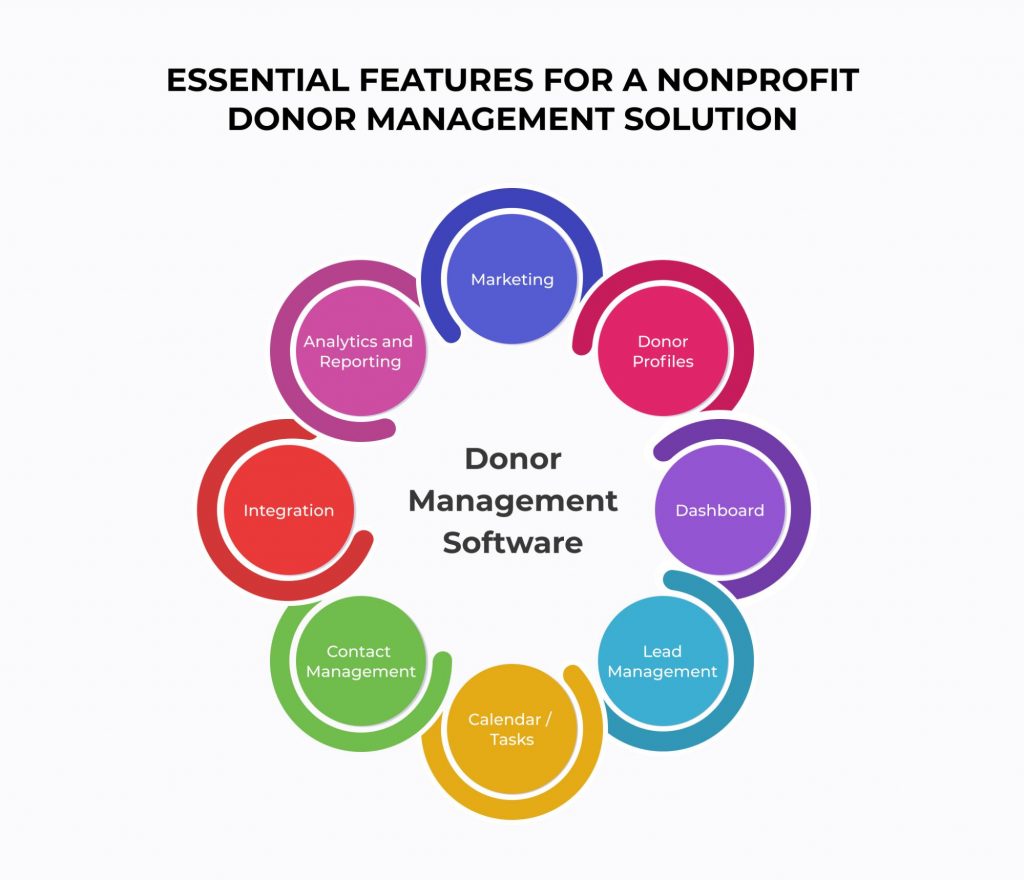
Using one of the off-the-shelf solutions for donor management can provide you with all the benefits described and even more. However, custom-made software will fit you like a glove, making all investments worthwhile. Luckily, there’s a way to speed up developing a custom donor management system and cut the overall costs. In our projects, we widely use DHTMLX and Webix. These libraries provide access to functional and configurable UI widgets perfect for building any web application, including donor management software. Let’s consider some key features they can help implement.
Dashboards
Dashboards can serve as visual snapshots of your fundraising health. Donor management software can be used to provide users with a centralized view of key metrics like total donations, donor acquisition, and campaign performance. These customizable dashboards can help you track progress toward fundraising goals and identify areas needing attention.
Read Also Clash of the Libraries. Building a Data Dashboard with React, Vue.js, and Webix
For similar tasks, we often use DHTMLX dashboard components:
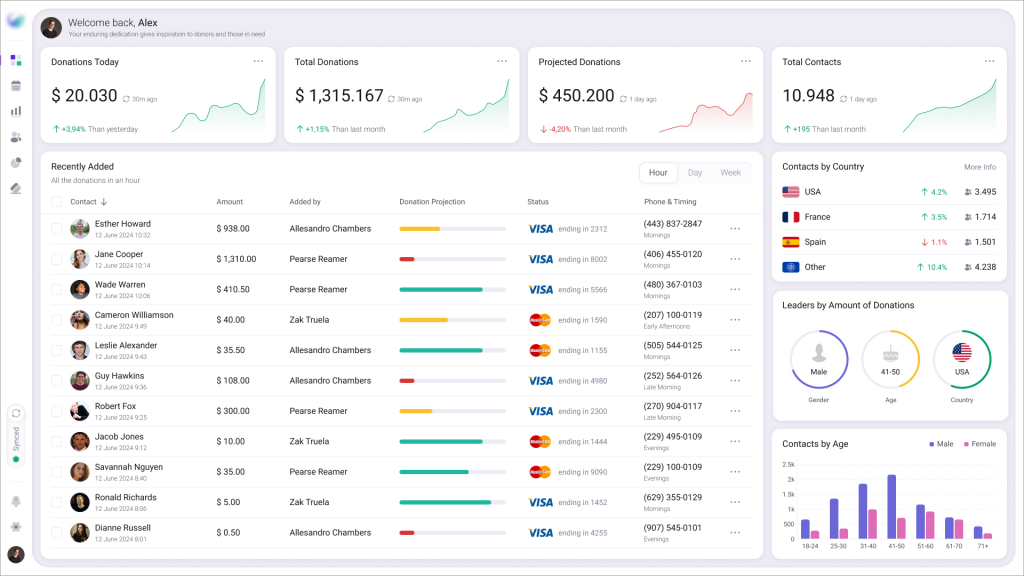
You can use any combination of DHTMLX components to build a dashboard that fully corresponds to your needs. For example:
- Layout can serve as the backbone, allowing you to create a user-friendly and organized dashboard layout. Dedicate specific areas for different functionalities, like a section for top donors, another one for recent donations, and a third one for campaign performance. You can even hide less frequently accessed information for a clutter-free experience;
- Grid is perfect for displaying donor information in a tabular format. It can display donor names, donation amounts, dates, and campaign affiliations. Sorting and filtering allow users to find specific donors or track trends by campaign quickly;
- Charts help visually represent donor data. Bar charts can showcase total donations over time. Pie charts can depict the distribution of donations by different channels (online, events, etc.), and line graphs can track the success of fundraising campaigns.
Reporting
Data can be useful not only as snapshots of the current state of affairs but also as reports summarizing your experience over specific periods of time. Donor management software can provide robust reporting features to measure campaign effectiveness. It can generate reports on donation amounts, giving frequencies, and donor demographics.
To implement such a feature, you can use the Webix Report Manager. It allows for creating, customizing, and distributing reports within donor management software. Its flexibility and versatility can help build apps that make a wide range of reports, including donor summaries, donation trends, campaign performance, and financial statements. Users can rely on pre-built templates and customizable report layouts to design visually appealing and easily understood reports.
Donor Profiles
Each donor requires personalized attention. For this, your management software solution must be able to create comprehensive profiles with detailed information, including giving history, communication preferences, and past interactions. These profiles will help you understand your donor base at a deeper level.
One of the possible solutions is to use DHTMLX DataGrid:
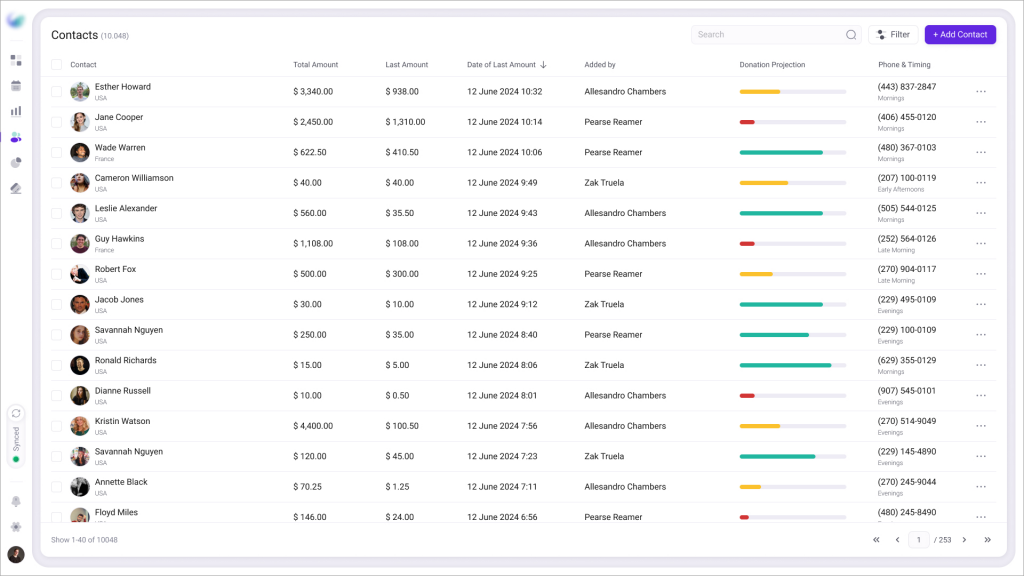
This powerful UI widget allows you to display and manage donor information in a tabular format. Features like sorting, filtering, and inline editing make it easy to keep donor records organized and accessible.
Event Management Tools
Such tools help seamlessly plan, promote, and track the success of fundraising events, galas, volunteer drives, and other donor-focused activities. From creating event registration pages to managing RSVPs and ticket sales, the automation and centralization provided by these features save organizations significant time and effort. The event management data can be directly synced with donor profiles, providing a holistic view of each supporter’s engagement. Features like event reminders, post-event surveys, and personalized communications help cultivate community and make donors feel valued.
DHTMLX JS Scheduler is the exact tool you can use to implement event management functionality in your donor management system:
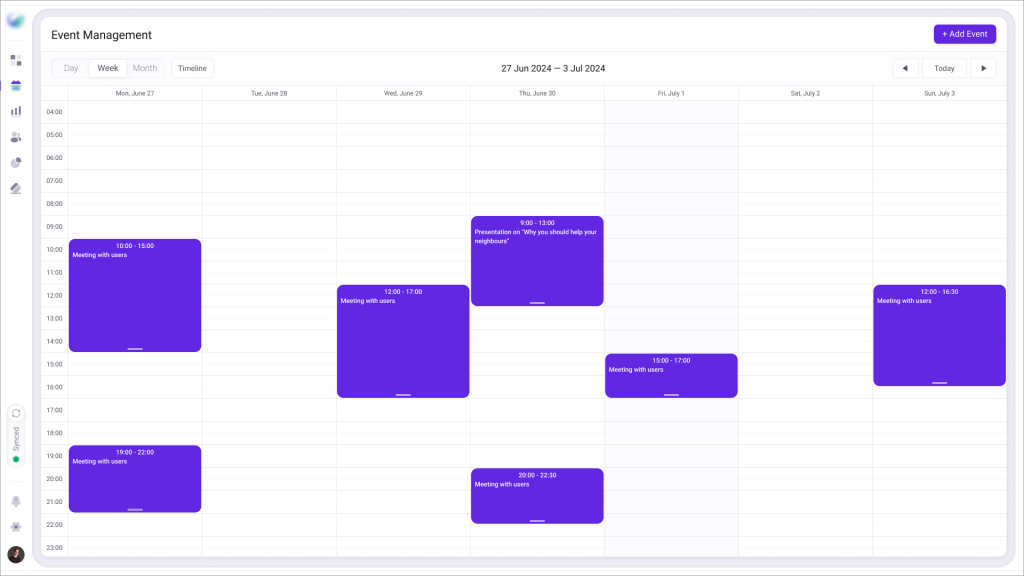
It’s perfect for scheduling donor meetings or tracking fundraising events. The scheduler offers various views (day, week, month) and allows easy drag-and-drop appointment management.
Donation Processing
Properly designed donor management software can make donations easy and convenient. It can integrate with secure online donation services, allowing donors to contribute effortlessly from any device. Online donation forms, for instance, enable donors to conveniently make gifts using credit cards, PayPal, or other preferred payment methods. These forms can be highly customized to match the organization’s branding and can even be integrated with third-party payment gateways to streamline the transaction process.
The Webix Form widget allows the creation of dynamic forms for various functionalities in your donor management software:
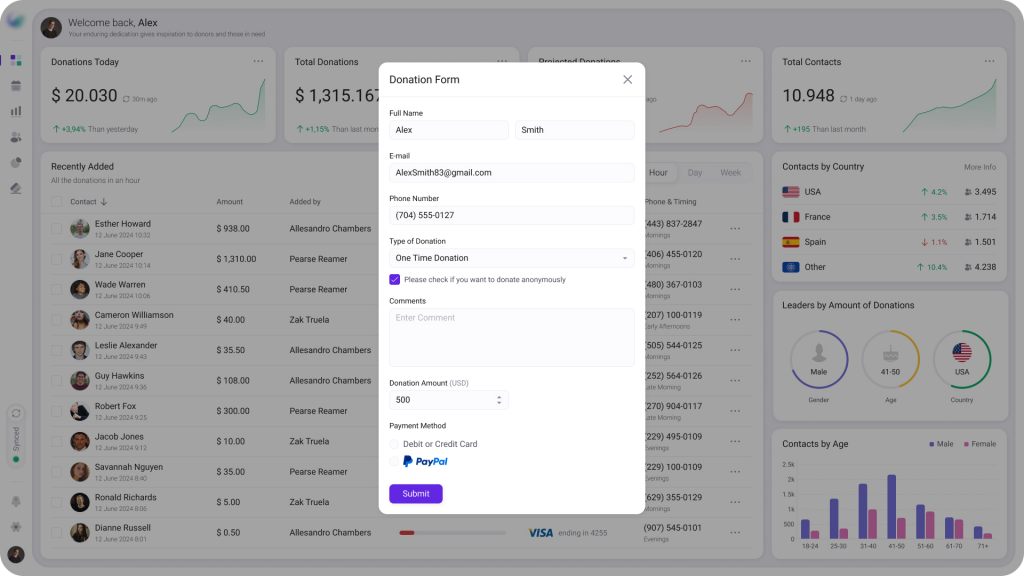
This component can be used to create intuitive online donation forms. It supports various input types and validation rules and can be easily integrated with payment gateways to streamline the donation process. Webix’s built-in data binding capabilities can ensure that all donation details are automatically synced with the donor’s profile in the central database.
Building a custom-made donor management system may seem pretty complex. There are many components with potential value, and you need to combine them and make them work together. Wouldn’t it be easier to use one of the available ready-made solutions instead? Well, it’ll definitely be easy. However, using custom software has its own advantages. In fact, custom software can offer benefits that off-the-shelf solutions can’t match. Let’s consider them in more detail.
Custom DMS Solutions vs. Off-the-Shelf Software
When it comes to donor management, organizations are faced with a critical choice: should they opt for custom software development or choose a ready-made product?
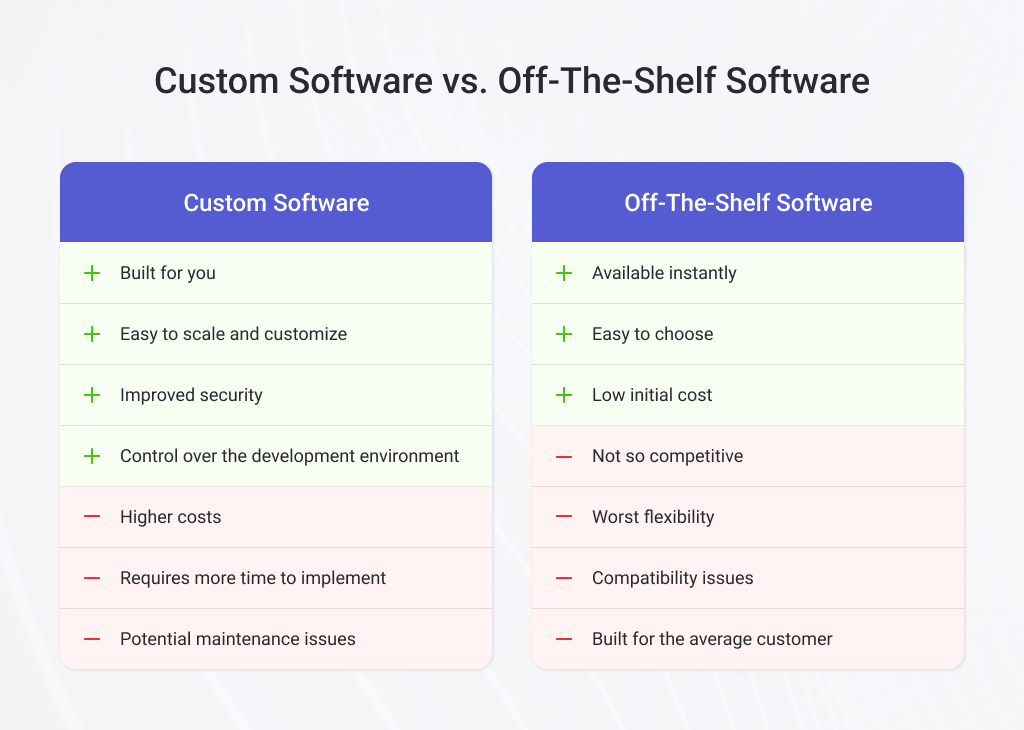
Custom-made donor management software offers a high degree of flexibility. By working with a software development team, nonprofits can build a system that perfectly aligns with their unique workflows, data requirements, and reporting needs. This level of customization can lead to greater efficiency and more insightful analytics.
However, the development of custom software also comes with a higher upfront cost and longer implementation timeline compared to off-the-shelf solutions. Nonprofits must invest significant time and resources into the design, development, and testing phases. There is also the ongoing expense of maintaining and upgrading the system as technology advances.
Read Also Off-The-Shelf Software vs Custom Software: Why Custom Option Wins
In contrast, ready-made donor management platforms provide a more cost-effective and rapid solution. These software-as-a-service (SaaS) offerings are designed to meet the common needs of nonprofits, with features such as donor tracking, online donation processing, and reporting dashboards. The subscription-based pricing model allows organizations to scale their usage as needed without large capital investments.
The tradeoff is that ready-made platforms may not offer the same level of customization as a bespoke solution. Organizations must adapt their processes to fit the software’s predetermined functionality, which could lead to compromises or the need for workarounds. Additionally, the long-term costs of a SaaS platform may exceed the upfront investment of a custom system, depending on an organization’s specific requirements and growth trajectory.
Conclusions
The philanthropic world doesn’t stand still and evolves following the changes in the technological landscape. There may be a lag compared to some industries relying on the most recent cutting-edge technologies. However, nothing stops you from using a generative AI system to craft personalized emails for your donors. You can use what modern web technologies offer and build the core features of your donor management software solution quickly and efficiently. Any feature you need, from robust donor databases and segmentation capabilities to integrated communication and event management tools, can be implemented to optimize your fundraising efforts and demonstrate a tangible impact on stakeholders. Contact us if you want to build a DMS solution from scratch, or modernize and upgrade the one you already use.